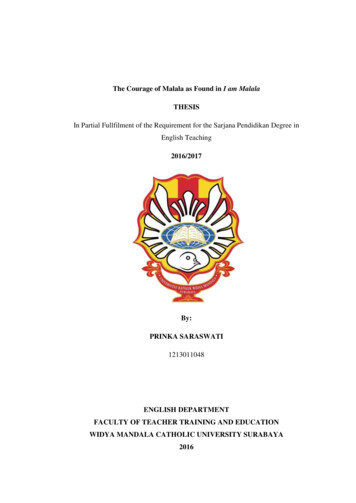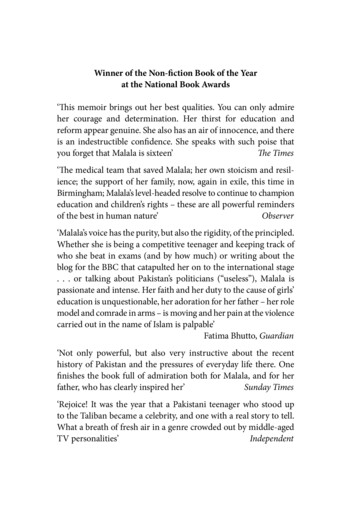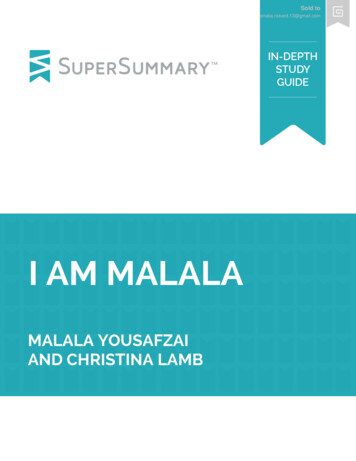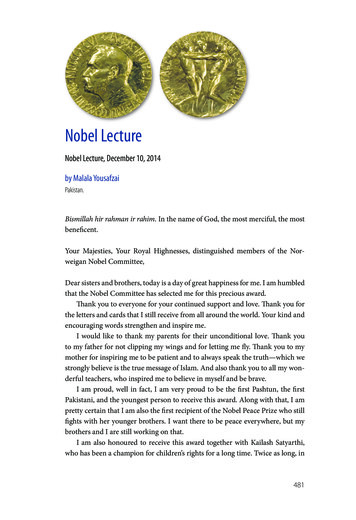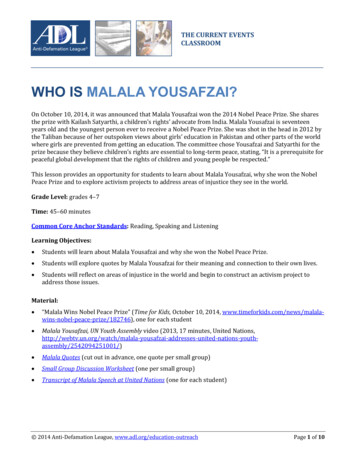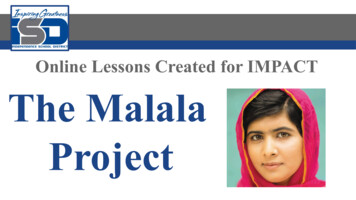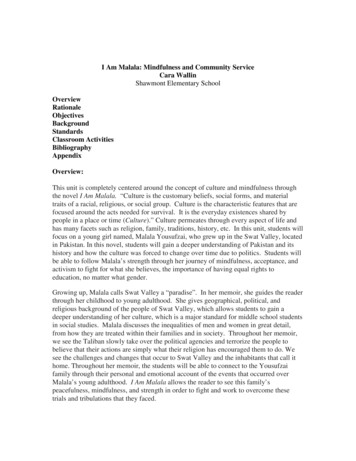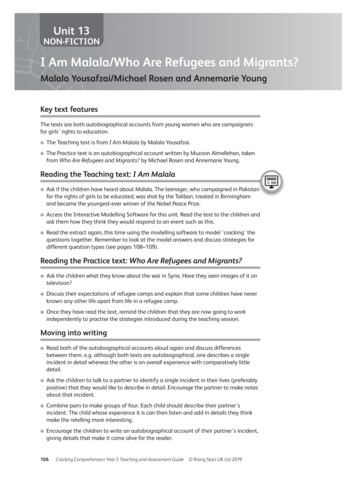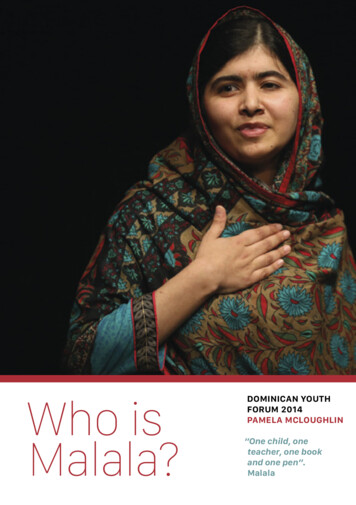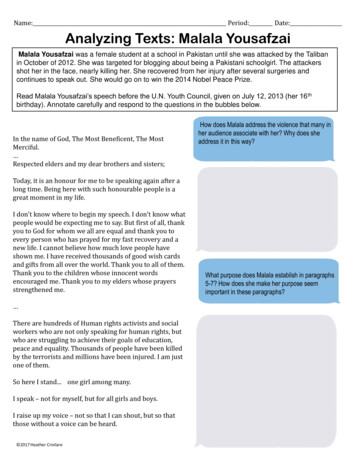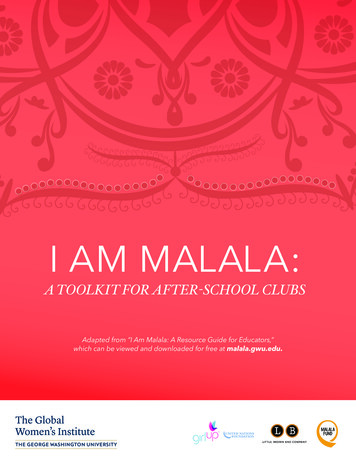
Transcription
I AM MALALA:A TOOLKIT FOR AFTER-SCHOOL CLUBSAdapted from “I Am Malala: A Resource Guide for Educators,”which can be viewed and downloaded for free at malala.gwu.edu.
Photo Credits (in order from top to bottom): Girl Up 2016; HUMAN forMalala Fund / Malin Fezehai; Girl Up / Lameck Luhanga / September 20152 Chapter
THEMES1. Memoir as Literature and History.32. Education: A Human Right for Girls.53. Cultural Politics, Gender, and History.94. Religion and Religious Extremism. 125. Malala and Violence Against Women and Girls. 156. Malala and Women’s Leadership. 187. Malala and the Media. 208. Global Feminisms: Speaking andActing about Women and Girls. 23This toolkit was designed for use by high school/secondary school students in after-school clubs.BEFORE YOU BEGINThe goal of this toolkit is to foster a healthy environment for sharingideas and experiences, not to put anyone on the spot, or be made tofeel exposed or unsafe. Develop ground rules for you and your club.EXAMPLES INCLUDE:1. Before you begin exploring eachtheme with your club, take a minuteto gauge the comfort levels ofyour members. Ask them if theyare comfortable discussing difficulttopics. If there are any topics thatmake someone feel particularlyuncomfortable, suggest it assomething to be read or researched athome, or discussed at a different time.You may also ask your club advisor tolead a blind vote to ensure membersfeel comfortable expressing their trueopinions.2. Everyone should feel safe saying theyare uncomfortable with a discussion.3. Everyone should respect others’opinions, allowing conversations to besafe, productive, and constructive.4. Violence against women and girls cantrigger many reactions within eachindividual due to various backgroundsand experiences. That being said, it isan incredibly important topic to learnabout and discuss if your club is able.3 Chapter
BACKGROUND“SWAT VALLEYAFGHANISTANPAKISTANINDIA“IRANMalala Yousafzai started her campaign for girls’education at the age of 10 when the Swat Valleywas being attacked by terrorists and education wasthreatened. She came to public attention at the ageof 11 by writing for BBC Urdu about life under theTaliban. Using the pen name Gul Makai, she oftenspoke about her family’s fight for girls’ educationin her community. In October 2012, Malala wastargeted by the Taliban and shot in the head as shewas returning from school on a bus. In recognitionof her courage and advocacy, Malala was the winnerof Pakistan’s National Youth Peace Prize in 2011.¹WHO IS MALALA?THE TOOLKIT: PEERS EDUCATING EACH OTHERMalala Yousafzai is a young Pakistani girls’ educationactivist. She gained global attention in 2012 when shesurvived a shot at point-blank range after being targetedby the Taliban for her education advocacy. In her memoir,I Am Malala: The Girl Who Stood Up for Education andWas Shot by the Taliban, Malala tells the story of herexperiences as a young girl living in the Swat Valleyin the face of violence and religious extremism. Usingher intelligence, compassion, and sheer force of will,Malala is a voice for change and a beacon of hopefor girls worldwide. At only 17 years old, Malala is theyoungest recipient of the 2014 Nobel Peace Prize for heroutstanding contributions to peace.This is where you come in! As an after-school group, youhave the unique opportunity to join Malala’s movementby learning from her story and implementing change inyour school, your community, and your world. The eightthemes in this toolkit provide a deeper understanding ofkey concepts from Malala’s story. Each theme starts witha quote from Malala’s memoir, background information,activities for your club, and additional discussion questionsand resources to deepen your knowledge. The goal of thistoolkit is to empower young, passionate people like you totake action.With her father, Ziauddin, Malala co-founded the MalalaFund in 2013, an organization dedicated to enable girls tocomplete 12 years of a free, safe, quality education so thatthey can achieve their potential and be positive changemakers in their families and communities.Using Malala’s story and this toolkit, you can work togetherto educate yourselves and each other and be the drivingforce behind real change in your community.To all the girls who have faced injustice and been silenced.TOGETHER WE WILL BE HEARD.—MALALA YOUSAFZAI1from I Am Malala: The Girl Who Stood Up for Education and Was Shot by the Taliban2 Background
MEMOIR AS LITERATUREAND HISTORY*Who is Malala? I am Malala andthis is my story.—MALALA YOUSAFZAIBACKGROUNDSo what’s a memoir? And what’s the difference betweena memoir and an autobiography? Or a diary?There are a few things that make a memoir stand out fromother nonfiction books. A memoir focuses on a “personalaccount of an event, a season, or a memory that is generallyvery personal, evocative, and focused.”But isn’t that the same thing as an autobiography? Notquite. Memoir differs from autobiography in that thememoir concerns a specific, concentrated period within alife, whereas an autobiography tends to recount the storyof a life that is generally more all-embracing, with a greaterchronological sweep and more linear structure.I Am Malala is a memoir because Malala walks us throughher experience of being attacked by the Taliban. She givesus her own insights and a very personal perspective ofwhat her life was like for a specific period of time. Memoirsmake powerful witnesses to history, and, in Malala’s case,a strong testament to injustice. Malala’s memoir illustratesthe power of contrasts—from descriptions of her assailant’sshaking hand as he shoots her at close range to teenagepreoccupations with Twilight books and arguments withMunneba, her loving but possessive best friend. National Geographic*Adapted from resource guide material written by Julie Donovan3 Memoir as Literature and History
ACTIVITYTAKE IT FURTHER!Now that you know what a memoir is, it’s time to try ityourself! Part of being an advocate for girls is selfreflection and this is an opportunity for you to do justthat. Take a moment and think about an experience inyour life that stands out to you. It can be positive, like ayear you discovered something you love. It may also be achallenging time in your life, like a fight with a friend or afamily tragedy.Why not make this digital? Build awareness and createinterest in Malala’s memoir by making Malala’s six-wordmemoir into posters and social media posts. Get permissionto put up the posters around school. Nothing gets studentstalking like clues, puzzles, and a game of “Guess Who?”Make your posters into a guessing game and then revealMalala’s identity over the school PA system. You can do thisfor other inspiring women leaders on March 8, InternationalWomen’s Day, too!Once you have that moment in mind, it’s time to getcreative! Think of SIX words to describe it—no more, noless. You can add illustrations, incorporate movement, oreven dance out your six words!ADDITIONAL RESOURCESCheck out the following memoirs to learn more about howimpactful one person’s story can be:SHARE YOUR SIX-WORD MEMOIRS AS A GROUP ANDTALK ABOUT YOUR REACTIONS: Why did you choose that moment? Was it difficult to come up with a way to describe thatmoment in your life in only six words? If so, why?Persepolis by Marjane SatrapiThree Little Words by Ashley Rhodes-CourterModel by Cheryl DiamondThe Bite of the Mango by Mariatu Kamara Why do you think a memoir might be morecompelling to read than an autobiography or adiary?DISCUSS How might your six-word memoir help othersunderstand something better in their lives, givesomeone comfort, or help someone grow? Can Malala’s memoir help us understand somethingbetter in our lives? In the lives of others? If so, how? What might Malala’s six-word memoir be?4 Memoir as Literature and History
EDUCATION: A HUMANRIGHT FOR GIRLS*Though we loved school, we hadn’t realized how importanteducation was until the Taliban tried to stop us.Going to schooL, reading and doing our homeworkwasn’t just a way of passing time, it was our future.—MALALA YOUSAFZAIBACKGROUNDAccording to the United Nations Educational, Scientific,and Cultural Organization (UNESCO), education is ahuman right and essential for the exercise of all otherrights. The Convention on the Elimination of All Forms ofDiscrimination Against Women calls upon states to take allappropriate measures to eliminate discrimination againstwomen in order to ensure them equal rights with men inthe field of education.While girls are gaining access to primary education,gender disparities still remain high. Around the world, girlsare unable to attend school for discriminatory reasons,including fear of violence. Girls are often discouraged fromcontinuing in STEM fields, expected to do more houseworkas young adults than boys, and in many areas of the worldare subject to forced and early child marriage. In 2013,123 million young people worldwide lacked basic literacyskills, and girls comprised 61% of that total. Improvingthe socio-economic outcomes for girls and young womenis of central importance not only for girls and womenthemselves, but also for their communities and futuregenerations.In July 2016, Malala spent her 19th birthday, Malala Day,visiting girls struggling to go to school in refugee campsin East Africa to make sure the world hears their stories.She launched the #YesAllGirls campaign during her visit toremind world leaders that they have promised 12 years offree, safe, quality education to all girls, including refugees.Malala believes that access to quality education is a humanright, for every girl as well as every boy. Education allowsus to learn more about others and ourselves, and engagemeaningfully with our world. However, across the worldmore than 130 million girls are denied this right as a resultof poverty, lack of access, violence, or discrimination.UNHCR / Jiro Ose / March 2014ACTIVITYThe purpose of this activity is to get you thinking about howpower and privilege can influence our lives, sometimeswithout us even realizing it. The goal is to identify andunderstand how even the simplest privilege—say, gettinga ride to school from a parent—can affect one’s education.By understanding that these privileges are not universal,we can identify the gaps in equality so as to work towardsensuring that all girls have the same opportunities to learn.*Adapted from resource guide material written by Michele A. Clark and Larisa Warhol5 Education: A Human Right for Girls
EDUCATION PRIVILEGE WALK*INSTRUCTIONS:Find a large room with open space, enough for each member of your group to stand an arm’s length apart in a straight line.Choose one person, either a club leader or member, to be the moderator. This person will be giving the instructions thatdetermine whether you step forwards, backwards, or stay in place during the walk.To be read by the Moderator:“We all come from different walks of life. Today, we’re going to illustrate just how somewalks are different from others—literally!This activity is meant to engage each member of the group in an exercise on privilege,as it relates to education as a human right for girls. I will say various statements out loudwith instructions and, as they pertain to you, you will step forward, backwards, or stay inplace. This activity should be done in silence. As you hear each question out loud, thinkto yourself about how it relates to you, your peers, and girls all over the world.Remember: If at any time you feel uncomfortable with a statement as it’s read, you canstay where you are.Everyone form a straight line with an arm’s length apart.”STATEMENTS:1.If the language spoken at your school is your first language, take one step forward2.If either of your parents or guardians graduated from college, take one step forward3.If you were/are being encouraged to apply for college by your family members, takeone step forward4.If you have visible or invisible learning disabilities, take one step backwards5.If your work and school holidays coincide with your religious holidays that youcelebrate, take one step forward6.If you have ever studied the culture and history of your ancestors in school, take onestep forward7.If you have been bullied based on something you cannot change (gender, ethnicity,sexual orientation), take one step backwards8.If you were ever offered a job or opportunity based upon your relationship with afriend or family member, take one step forward*Adapted from the Privilege Walk Activity from State University of New York, found at: http://www.albany.edu/ssw/efc/pdf/Module%205 1 Privilege%20Walk%20Activity.pdf6 Education: A Human Right for Girls
9.If you feel you were ever passed over on a job or opportunity based on yourgender, ethnicity, or age, take one step backwards10. If you come from a family environment that encourages taking challengingcourses in your educational career, take one step forward11. If you receive a regular allowance from your family, take one step forward12. If you were ever uncomfortable about a joke or statement you overheard aboutyour race, ethnicity, gender, appearance, or sexual orientation but felt unsafeconfronting the situation, take one step backwards13. If you rely on public transportation to get to school, take one step backwards14. If you have ever felt unsafe walking at night, take one step backwards15. If you have ever felt like your opinion was valued less than another classmate’sby your instructor or peers based on you race, ethnicity, gender, appearance, orsexual orientation, take one step backwards16. If you can look at the mainstream media and find people of your race/ethnicityrepresented fairly and in a wide range of roles, take one step forwardTo be read by the Moderator:“Take a minute to look around you, and, without speaking, think about where youended up. Where are you in relation to your peers? What statements, if any, struck youin particular? Where might you be if this activity was being done in another country,such as Pakistan?”When everyone has taken a moment to gather themselves, take a break. Grab a snack or sip of water and allow yourself amoment to decompress. When you’re ready, come back as a club to discuss.DISCUSSTAKE IT FURTHER! What was your initial reaction to where you foundyourself at the end of this list of privileges? Have you come to any new realizations? If so, whichone has the strongest impact? What challenges/gaps in equality do girls face whenit comes to education? What can we do to minimize those gaps? Where do you think Malala would be standing at theend of the Education Privilege Walk? Why?Join Malala’s movement! Visit malala.org to learn how youcan Stand #withMalala and demand a quality education forevery girl. Use your creativity and passion to take an activerole by spreading awareness or advocating for every girl toget 12 years of a free, safe, quality education.Want to try this activity again? Download Girl Up’s “A Walkin Her Shoes” (http://bit.ly/2erueM8), which takes youthrough the journey of both Ethiopian refugee girls andGuatemalan indigenous girls in UN programs as theystruggle for their education as well.7 Education: A Human Right for Girls
ADDITIONAL RESOURCESWATCH:WATCH:“HE NAMED ME MALALA”“TO EDUCATE A GIRL,” UNICEFDVD is available for purchase at:http://www.henamedmemalalamovie.com o-educate-a-girlGather a group of friends or classmates for a screeningof the film on campus or at your after-school club. Visitmalala.org/students for more information and resources,including the discussion guide to help facilitate aconversation following the film.In 2010, filmmakers Frederick Rendina and OrenRudavsky traveled to Nepal and Uganda, two countriesemerging from conflict and struggling with poverty,to find the answer to one question: what does it taketo educate a girl? Framed by the United Nations Girls’Education Initiative (UNGEI) to provide equal access toeducation for girls by 2015, “To Educate a Girl” takesa ground-up and visually stunning view of that effortthrough the eyes of girls out of school, starting school orfighting against the odds to stay in school.You can also watch the video about the Malala Fund:https://vimeo.com/141199855WATCH:Discuss:“A GIRL WHO DEMANDED SCHOOL:KAKENYA NTAIYA”1. What are some challenges that girls face when tryingto obtain equal access to an education? Compare andcontrast Uganda and Nepal.http://www.ted.com/talks/kakenya ntaiya a girlwho demanded schoolKakenya Ntaiya made a deal with her father: She wouldundergo the traditional Maasai rite of passage of femalecircumcision if he would let her go to high school. Ntaiyatells the fearless story of continuing on to college, and ofworking with her village elders to build a school for girlsin her community. It’s the educational journey of one thataltered the destiny of 125 young women.2. What are major organizations doing to address thechallenges of educating girls? What more can bedone to ensure girls have the opportunity to attendschool?WATCH:DARE TO EDUCATE AFGHAN GIRLS: SHABANABASIJ-RASIKHDiscuss:1. What is female genital mutilation (FGM) and why is itprevalent in Kenya? How does it affect girls? http://www.ted.com/talks/shabana basij rasikhdare to educate afghan girls#t-5489542. If you were a human rights expert, what could you doto challenge this practice? How is Kakenya Ntaiya aninspiration to girls and women around the world?Imagine a country where girls must sneak out to go toschool, with deadly consequences if they get caughtlearning. This was Afghanistan under the Taliban, andtraces of that danger remain today. 22-year-old ShabanaBasij-Rasikh runs a school for girls in Afghanistan. Shecelebrates the power of a family’s decision to believe intheir daughters—and tells the story of one brave fatherwho stood up to local threats.Discuss:1. What are the consequences of not educatinggirls around the world, especially in places likeAfghanistan?2. What do you find inspiring about Shabana, her father,and their belief in education?8 Education: A Human Right for Girls
CULTURAL POLITICS,GENDER, AND HISTORY*We talked about how things happen for different reasons, this happened tome, and how education for females not just males is one of our Islamic rights.I was speaking up for my right as a Muslimwoman to be able to go to school.—MALALA YOUSAFZAIBACKGROUND“Culture” is the social context of a group of people. Culture can include values, beliefs, religions, laws, and arts which shape lifefor that group. Culture can change throughout history.Throughout history and across regions, women have frequently faced discrimination and abuse in the name of culture.Pakistan became an independent country in 1947. From its inception, there were tensions between Hindus and Muslims.During Pakistan’s independence movement, there was heightened ethnic conflict, and women became targets of violence anddiscrimination. We see these trends continue in Malala’s story; as she grew up in Swat Valley, Pakistan under Taliban rule, girlstended to have far fewer privileges than boys—including the right to be educated.Much of Malala’s story both illustrates and combats this “cultural privileging” of boys, particularly as it relates to education.A few examples of “cultural privileging” include: Birth of a child: The birth of a son is often greetedwith celebration, whereas the birth of a daughter canbe a cause for mourning. In some parts of the world,women who give birth to sons are honored, whereaswomen who give birth to daughters are shamed. Son Preference: In some parts of the world sonsare preferred over daughters so much that familiespractice sex-selective abortion, favoring boys overgirls. Food distribution: Men and boys are served foodfirst; women and girls are served last. In times ofhardship, women and girls may bear the brunt offood scarcity more than men and boys. Education: With limited resources, a family will investin the education of a son rather than a daughtersince the daughter is believed to inevitably marryand live with her husband’s family. Moreover, thepredominance of male teachers contributes to theunder-matriculation of girls, notably in conservativecultures where girls and boys are educatedseparately. In co-educational schools, sexism leadsto boys getting more attention and praise than girls,particularly in regards to math and science. Thisunequal treatment affects female students’ selfconception and success. Child Marriage: Child marriage is the marital uniona person enters into before reaching the age of 18.Often child brides are dependent on their husbandsand denied fundamental rights to education, health,and safety. Child marriage often occurs due tocultural traditions and poverty. Bride Price: Bride prices are monetary sums givento impoverished families in exchange for a girl orwoman to be married.*Adapted from resource guide material written by Kavita Daiya9 Cultural Politics, Gender, and History
Malala was raised in a culture that does not supportfemale education. Some view the education of girls ascounter-cultural and a negative Western conspiracy andideology. As a result, Malala has met much opposition.But the challenges she has faced have only strengthenedher mission and amplified her voice. Malala continues tochallenge barriers to girls’ access to education around theworld.The U.S. has its own cultural privileges that favor men.For example, the No Ceilings Campaign reports that aU.S. woman on average earns about 78 cents for everyman’s dollar (an African American and Latina woman, onaverage, earn even less); the U.S. is one of nine countriesworldwide that does not provide paid maternity leave; and,while women make up a majority of moviegoers, they onlyconstitute 7% of the directors.Girl Up / Neel Dhanesha / December 2015It is often thought that culture is intractable and cannot bechanged. The fact is culture CAN be changed. Everyonecomes from a different culture and EVERY culture haselements that don’t serve the rights of all in the community.You CAN change it and people have changed negativeelements of their culture across the world.Girl Up / Lameck Luhanga / September 2015ACTIVITYThe purpose of this activity is to expose you to the different kinds of feminist organizations and activists across the globe—andto become one of them! By understanding the interconnected relationship between history, culture, and gender, we can betterunderstand how to engage with these concepts to promote equality.As a group, study one or two different feminist activists or women’s organizations. They can be based in the United States orabroad. Identify the focal issue for the activists or organizations—be it education, human rights, domestic violence prevention,rural development, etc. Be sure to also research the tools they use to accomplish their goals. (Tip: A great place to start yourresearch is MAKERS, a website devoted to accomplished and powerful U.S. women across many different fields.)Once you’ve chosen an activist or organization, think about the ways in which those focal issues are addressed. How do theyspread their message? Do they have a website, make videos or use social media to promote grassroots campaigns?TAKE IT FURTHER!As a group, choose one issue you’d like to address and create your own action plan! Talk about the history behind the issue—find thecontext and the cultural or political factors thatmotivate each side—the Who? What? Where? When?and Why? of the issue will give you the backgroundinformation needed for your action plan. Spread the word! Create a “Did You Know?” poster,photo series, Prezi, or PowerPoint and ask a teacher toshare it in the classroom! Include information aboutyour issue, what you think could be done to helpsolve it, and how others can join your movement. What are your goals? What people do you want toeducate? Your classmates, your parents, or the largercommunity? How do you want to educate people?You could write a blog post, table at your school, orfind a real life organization at which to volunteer.10 Cultural Politics, Gender, and History
ADDITIONAL RESOURCESLISTEN:WATCH:“THE LIVES OF WOMEN IN AFGHANISTAN:INTERVIEW WITH istaninterview-leilaDiscuss:1. How was Leila’s life shaped by cultural politics,particularly her status as a refugee?2. How is Leila different than the stereotypical image thatis generally presented of Muslim women?“WAYLOWAYLO,”TOSTAN o takes place in the community of TankantoMaoundé. Waylowaylo means “change” in Pulaar, andthe film shows the changes in attitude in the communitytowards girls’ education through the story of a girl namedMaoundé Baldé and her father, Mamadou Baldé, theVillage Chief.3. What is Leila’s opinion of the Taliban occupation ofAfghanistan?Source: Tostan International4. Think about your own culture—is there anything in yourculture that discriminates against women?1. What cultural factors led Maoundé’s father to initiallynot allow her to continue her education?5. What groups are working to address any culturaldiscrimination that may be occurring in your culture?2. What role do men play in ensuring equal opportunityfor women?Discuss:3. What impact will Maoundé’s education have on futuregenerations? What impact will your education have onfuture generations?WATCH:“SASA! A FILM ABOUT WOMEN, VIOLENCE,AND HIV/AIDS”https://youtu.be/jzR UlNbvZg“Sasa” is a Kiswahili word, meaning “now.” Now is thetime to begin thinking differently about preventingviolence against women and HIV/AIDS. The 30-minutedocumentary film tells two women’s personal stories ofviolence and HIV/AIDS.Source: Raising Voices: SASA! A film about Women,Violence and HIV/AIDSDiscuss:1. What are the commonalities between the women inthe film?2. What is a bride-price and what influence did it have onwomen’s relationships with their husbands?11 Cultural Politics, Gender, and History
RELIGION ANDRELIGIOUS EXTREMISM*Because of the Taliban, the whole world is claiming we are terrorists.This is not the case. We are peace-loving. Our mountains, our trees,our flowers—everything in our valley is about peace.—MALALA YOUSAFZAIBACKGROUND“Islam is arguably the most misunderstood religion of the 21st century.” 2WHAT IS ISLAM?Islam is a monotheistic religion. It began in the 7th century AD in what is now Saudi Arabia, led by the Prophet Muhammad 3who Muslims believe is the last prophet of Allah (the Arabic word for God). Followers, known as Muslims, adhere to the Qur’an,the central text of Islam, and follow 5 pillars of faith:1. Shahada: There is only one god, God, andMuhammad is his prophet4. Hajj: Pilgrimage to Mecca during the monthof Dhu al-Hijjah2. Salat: Ritual prayer five times a day5. Sawm: Fasting during the month of Ramadhan3. Zakat: Giving alms to the poorWHERE IS ISLAM PRACTICED?Over 1.5 billion people in the world are adherents of Islam. In other words, 23% of the world’s population is Muslim. Islam isthe religion of various people around the world in places such as North America, Europe, the Middle East, Africa, and Asia.Islam is often exclusively associated with the Middle East, although only 15-18% of the world’s Muslim population is Arab. Infact, the country with the largest Muslim population in the world is Indonesia. Approximately five to six million Muslims live inNorth America. A number of leading scientists, physicians, athletes, and scholars are Muslims.*Adapted from resource guide material written by Kelly Pemberton2Kelly Pemberton, Associate Professor of Religion and Women’s Studies, The George Washington University3 he salawat, “salah allahu alaihi wa sallam”, is a phrase that Muslims use to pronounce blessings upon the Prophet Muhammad . Sometimes the phrase is abbreviated as SAW or PBUH for “peace beTupon him,” but these abbreviations are controversial and to some, suggest a lack of respect. With this in mind, we have used the full salawat in Arabic, as a superscript, in line with contemporary literaryconventions seen in texts about Islam.12 Religion and Religious Extremism
WHAT IS RELIGIOUS EXTREMISM?Religious extremism is any behavior, attitude, or belief outside the norm of religious beliefs or practices. Often, this extremismmanifests itself in the form of violence or the creation of smaller groups or cults. Religious extremism is present in all religions. Some groups, like the Taliban, have interpretedselect Islamic religious practices in ways whichhave suppressed human rights. Likewise, extremistChristian, Buddhist, and Hindu groups havecommitted acts of violence that do not align with thecore values of the religions they claim to represent. Because of terrorism and the media, manymisunderstand Islam and often mix up the practicesof a small minority with the entire religion. ManyIslamic people challenge extremism in their ownreligion. Malala remains a devout Muslim while condemningthe religious extremism of the Taliban.ACTIVITYThe purpose of this activity is to gain a broader understanding of religious extremism and how it can be dangerously confusedwith mainstream religious principles. By distinguishing the two, and by understanding that religious extremism pervades everymajor religion, not just Islam, we can better understand how many more things there are that bring us together than there arethat
I Am Malala: The Girl Who Stood Up for Education and Was Shot by the Taliban, Malala tells the story of her experiences as a young girl living in the Swat Valley in the face of violence and religious extremism. Using her intelligence, compassion, and sheer force of will, Malala is a v
